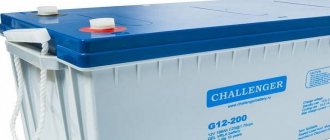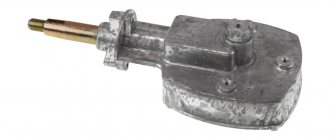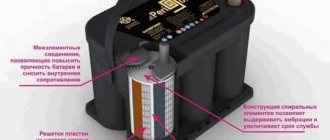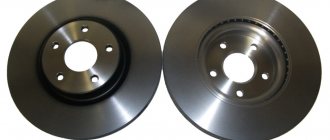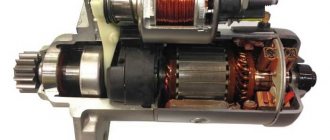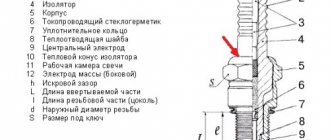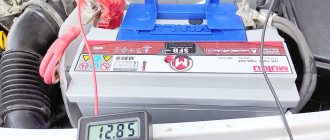Modern energy storage devices can use alkaline and acidic electrolytes in gel, liquid and dry form. The lead acid battery has been around for a century, but has not lost its relevance. New technologies have appeared. In particular, if the electrolyte is converted into a gel using a special chemical additive, the result is a gel battery.
How to maintain a gel scooter battery
Gel batteries are a modern type of battery that can be installed on any type of vehicle, but they are most popular among owners of scooters and motorcycles, as they work great during any prolonged and frequent tilting of the vehicle during maneuvers.
Manufacturers of some gel batteries claim that the current supply will not stop even if the battery is completely turned over, but here they slightly exaggerate the battery's capabilities, and we strongly do not recommend doing this. A gel battery is a modified acid battery. The main difference is that due to the addition of certain substances (mainly silicon), the electrolyte changes from a liquid form to a gel form and is also capable of storing energy. In general, a gel battery also consists of six (less often three) cans in which lead plates are placed. Between the plates there is a gel-like electrolyte that stores energy and at the same time acts as a dielectric. When purchasing a new battery, most often the container with electrolyte is located separately and you will need to fill it into the battery yourself; this is quite simple to do.
The latest development from American manufacturers OPTIMA is gel batteries with flexible plates rolled into a roll. A gel-like electrolyte is also located between them. This design of the plates allows you to increase the battery capacity.
In any case, gel batteries are maintenance-free and this is one of their main advantages, especially for beginners. Indeed, you buy a battery, install it in a scooter and can enjoy riding without bothering with checking the electrolyte level, refueling and other procedures. However, the concept of “maintenance-free” is still very relative and gel batteries also require little maintenance. A little about how to maintain a gel battery for a scooter:
- It is necessary to check its charge periodically. This is done using a special electronic device - a multimeter. A multimeter makes it possible to check the charge without removing the battery from the scooter. We connect the probes and turn on the DC current at 20V. We check the charge both when the engine is not running (it should be about 12V, if less, then you need to charge the battery), and also when the engine is running, the charge should not exceed 15V. If this indicator is exceeded, the gel may boil and peel off from the plates; the most common cause of excess charge is a faulty charging relay. One more nuance: if the indicator indicators are not established when the engine is running, then it is worth replacing the spark plug cap.
- Despite the fact that gel batteries retain a charge for a long time in idle mode, the need to recharge remains, at least once a season.
- During winter, it is recommended to remove the battery from the scooter and store it at home or in the garage. Despite the frost resistance, at temperatures below minus 25 degrees the electrolyte becomes fragile, destroyed and cannot be restored.
In addition to the fact that gel batteries require virtually no maintenance, they have a number of undeniable advantages:
- They work in any position, with any inclination of the vehicle, which is what made them popular among scooter owners.
- They provide high current when starting the engine; in fact, such a battery can start any vehicle. This is ensured by plates made of pure lead; thanks to their low internal resistance, they quickly release a charge of up to 1000A (!), when conventional batteries provide a charge of 300-500 A. They work effectively even at a low charge level.
- They can withstand really deep discharges (zero), after which they are restored. Moreover, there can be up to 400 such restorations (!), while acid batteries will withstand no more than 20 cycles.
- When in idle mode, it is able to maintain the charge at a high level for a long time (in a year, a gel battery loses no more than 15% of its charge).
- Safety. The battery case is made of high-strength plastic, but even if it is damaged, there is no leakage of liquid or evaporation of harmful gases.
- When used correctly, gel batteries have a long service life (up to 10 years). The disadvantages of gel batteries are, first of all, the high price, as well as sensitivity to voltage surges, which is especially important when charging a gel battery.
Many scooter owners are interested in the question: is it possible to charge a gel battery on a scooter, to which there is a clear answer: this can and should be done at least once a season to maintain good battery performance.
Below are the basic rules on how to properly charge a gel battery for a scooter:
- Use only a special charger; chargers for car batteries are not recommended. The fact is that the charge power that is set on the device should not exceed 10% of the battery power (it is indicated on the battery itself). Those. if the power is 4 Am, then set to 0.4 Am. The power of gel batteries is small and rarely exceeds 7Am, while the minimum power for most car chargers starts at 2Am. In addition, the gel is sensitive to increased voltage, the recommended threshold voltage is 14.2-14.4 V; when the voltage exceeds 15 V, the gel begins to peel off from the plates, which leads to a short circuit and death of the battery.
- Gel batteries cannot be overcharged, that is, it is necessary to ensure voltage without surges, which is achieved with the help of voltage stabilizers.
- The battery should be fully charged, which will take about 12 hours. If the charge is not full, then most often the next time you recharge the battery will not gain maximum energy.
If all conditions are met, the gel battery can withstand up to 1000 charges and last up to 10 years.
What to do if the gel battery on the scooter does not charge. If the current flows poorly, then first you can try to increase the voltage to 20V, but do not miss the recovery moment, otherwise the battery will ignite. If this technique is not effective, then you can try to restore the battery.
Maintenance: how to restore a gel battery, replacing the electrolyte
If you maintain the power supply according to the manufacturer's recommendations, then most likely it will serve its service life without problems and will not require additional actions. If the power supply is swollen or the plates are destroyed, we recommend that you do not restore it, but purchase a new one. In what cases can you try to revive a gel battery?
If you notice a loss of capacity in your battery, then the gel component may have dried out. In this case, it is necessary to restore the water balance of the element using distilled water. Next we will tell you step by step how to do this.
- Remove the plastic cover.
- Remove the rubber seals on the jars.
- Take a syringe and draw 1-2 cubes of distilled water.
- Pour water into each jar.
- Leave the battery for several hours to allow the gel to soak in water.
- If there is not enough water, add more; if there is excess, remove it with a syringe.
- Check the voltage level at the terminals.
- Replace the plugs and close the battery cap.
- Place the battery on charge.
Also, reviving the battery may be necessary if there is severe sulfation of the plates, which forms during battery operation. There are two methods of desulfation:
- Using the chemical composition Trilon V. It must be purchased, diluted in the specified proportion and poured into a previously drained battery. Please note that in gel batteries it is not always possible to completely remove the electrolyte in the form of a gel. After desulfation with Trilon B, you will need to rinse the insides with distilled water, pour the gel electrolyte into the battery again, having previously prepared the solution. As you can see, the method is quite troublesome and requires knowledge and skills.
- Using pulse currents of various amplitudes. During this operation, pulsed currents destroy lead sulfate. It is worth noting that gel batteries, as mentioned above, react extremely negatively to sudden voltage changes and increased currents. Users who have tried this method say that it is not always possible to achieve their goal. This is explained by the fact that in addition to lead sulfate, the plates themselves are destroyed, and this entails a loss of capacity.
As you can see, there are ways to recondition batteries, however, they are not very suitable for gel power sources. We recommend not trying to revive a gel battery, but purchasing a new one.
Is it possible to fill a gel battery with electrolyte or water?
As part of the maintenance of gel batteries, you can add distilled water to them in the manner that we described above. It is not recommended to pour ordinary tap water into power sources - it contains too many impurities that will interfere with the proper reaction.
Gel batteries for cars are quite popular due to the lack of maintenance required. As you can see, the operation of these power supplies is extremely simple. However, many are put off by their high cost. With proper maintenance - timely recharging, compliance with storage conditions - this battery will last a long time, and restoring capacity will not take much time and effort. How do you care for a gel battery? Have you ever encountered problems while charging or restoring? Share your experience with our readers.
Professional tips on how to charge a gel battery for a scooter
Life rushes us more and more. Moving around the area, even in small towns, not to mention big cities and metropolitan areas, is getting faster and faster. Everyone chooses wheeled vehicles according to their taste and family characteristics, both financial and physical. The number of people who choose to travel on two-wheeled motor vehicles is growing significantly every year. And the largest percentage of this equipment is scooters. They have a number of advantages over their larger counterparts in the form of a moped and a motorcycle. Well, and accordingly, an even greater advantage over its brother in the form of a bicycle. Changing from a bike to a scooter will not be difficult. The weight of the most common scooter model ranges from 60 kilograms, so keeping balance with it is not difficult.
Advantages of a scooter with gel batteries
Automatic transmission, electric engine start, ease of getting on the scooter due to the absence of a gas tank in the front, affordable price and operation without a driver's license. All these are quite significant advantages when the question arises of acquiring a scooter. Having become the owner of a scooter, the first thing you should do is remain its owner. We are talking about alarm systems, of which there are sufficient quantities on the motor market today to suit every financial taste.
There are several types of scooters - city scooters, exclusively for short trips on smooth asphalt, scooters with a retro design in the style of the 50s, and cruiser scooters, designed for long rides in comfort. And to ensure constant comfort when driving and starting, it is recommended to install gel batteries on scooters . What is the difference between a gel battery and the most common acid battery?
Appearance of a gel battery for a moped
Scope of application
AGM and GEL for car
Home battery
The sealed housing prevents electrolyte from escaping outside. Gel batteries for cars are capable of supplying a high current to the starter, which ensures an almost instantaneous start of the engine. While the engine is running, the battery restores its potential by receiving a charge from the generator.
At home
Household gel batteries have proven to be excellent sources of emergency power supply. In areas where the central power grid suffers from frequent power outages, compact batteries are capable of supporting the operation of computer and television equipment for a long time.
Autonomous power supplies quickly restore charge when the current is turned on. They can be connected in parallel. Blocks of several batteries make it possible to provide power for external and internal lighting devices and non-energy-intensive household appliances for a long time.
Household gel battery Delta
Important! It is necessary to monitor the operating temperature of the equipment. Overheating of the battery can cause an explosion, which will lead to loss of battery.
Operating principle of a gel battery
The gel base is created using various additives in the form of silicon added to the electrolyte. Due to this, the electrolyte turns into a thick gel. Considering that when driving a scooter its inclination constantly changes, with the installation of a gel battery, you don’t have to worry that the current supply will be interrupted. The gel better fills the space between the plates inside, which helps to significantly reduce their wear during severe discharge. Studies of a gel battery when driving a scooter showed the result that with prolonged and frequent inclinations, the charge level decreases by 25%. Although many manufacturing companies indicate in advertising information that such a battery will work upside down, this is not the case. Just a publicity stunt. Knowing and following all the rules for using a gel battery, it is quite possible to extend its service life to ten years.
Diagram of the internal structure of a gel battery
How to properly prepare electrolyte at home: safety precautions
Separately, I would like to draw attention to modern lead-acid power supplies - gel and AGM. They can also be filled with a personally prepared solution, which is in a specific form - in the form of a gel or inside separators.
Nickel-cadmium and iron-nickel batteries
Unlike lead power sources, cadmium- and iron-nickel ones are filled with an alkaline solution, which is a mixture of distilled water and caustic potassium or sodium. Lithium hydroxide, which is part of this solution for certain temperature conditions, allows you to increase the service life of the battery.
Table 2. Composition and density of electrolyte for cadmium- and iron-nickel batteries.
It is recommended to operate nickel-iron power supplies under the same conditions as cadmium-nickel ones. However, it is worth noting that they are more susceptible to low temperatures. Therefore, they should be used up to minus 20 degrees.
Preparing a solution involves working with acids and alkalis, so taking precautions is necessary for the most experienced people. Before you begin, prepare your protective equipment:
- latex gloves
- chemical-resistant clothing and apron;
- protective glasses;
- ammonia, soda ash or boric solution to neutralize acid and alkali.
Equipment
To prepare battery electrolyte, in addition to the power source itself, you will need the following items:
- container and stick, resistant to acids and alkalis;
- distilled water;
- instruments for measuring the level, density and temperature of the solution;
- battery sulfur liquid - for acid batteries, solid or liquid alkalis, lithium - for the corresponding types of batteries, silica gel - for gel batteries.
Process sequence: making an electrolyte for a lead-acid power source
Before starting work, read the information given in Table 3. It will allow you to select the required volume of liquids. The batteries contain from 2.6 to 3.7 liters of acid solution. We recommend diluting approximately 4 liters of electrolyte.
Table 3. Proportions of water and sulfuric acid.
- Pour the required volume of water into a container that is resistant to caustic substances.
- The water should be diluted with acid gradually.
- At the end of the infusion process, measure the density of the resulting electrolyte using a hydrometer.
- Let the composition sit for about 12 hours.
Table 4. Electrolyte density for different climates.
The concentration of the acid solution must be related to the minimum temperature at which the battery is operated. If the liquid is too concentrated, it must be diluted with distilled water.
Watch the video on how to measure the density of an electrolyte.
Attention! You cannot pour water into acid! As a result of this chemical reaction, the composition may boil, which will lead to its splashing and the possibility of acid burns!
Please note that heat is generated during mixing of the components. The cooled solution should be poured into the prepared battery.
DETAILS: The best car body polish
Pros of a gel battery:
- Thanks to the gel filling, they produce a high current when starting;
- Significant service life, of course, subject to compliance with operating rules;
- Possibility of use immediately after purchase, since it is not serviced;
- If the case is damaged, the contents do not leak, unlike its lead counterpart;
- Almost does not pay attention to changes in the position of the scooter;
- Considered one of the safest types of batteries in the world;
- Tolerates winter and frost well in general;
- Minor disadvantages:
- High voltage accuracy when charging;
- The price is several times higher than the cost of lead batteries.
Recovery methods
In general terms, restoration work is based on replenishing water in a gel-like electrolyte. This is done by adding fluid to the required level. In addition, the battery should be charged. Depending on the level of voltage reduction at the input terminals of the device or its technical condition, constant charging for a long time or cyclic charging can be used.
Filling distillate
The process of loss of water by an electrolyte with a gel-like consistency occurs due to the simple reason of hydrogen leaving the cavity of the cans. During the process of charge and discharge, a current is generated at the electrodes, which is obtained from the division of water into a hydroxyl group and individual hydrogen ions. In the environment of an electrolytic liquid, hydrogen cannot find a “shelter” for itself and, instead of remaining inside and again taking part in reactions, it rushes out through the rubber valves. As a consequence, the formation of water back in the previous volume is unrealistic, since part of its chemical composition is lost irretrievably.
This process leads to a decrease in the concentration of the distillate, which for the gel threatens its drying out and loss of properties as an electrolytic material. In many gel-based devices, the manufacturer puts the inscription “Do not open” on the lid to prevent damage associated with depressurization of the battery. But without violating this rule, it is impossible to add distillate to the overdried gel mass.
To carry out maintenance of such a battery, you will need to tear off the cover and remove all valve caps. The level of distillate added should be slightly lower from the edge of the neck of the jar. To improve the uniformity of water absorption, use filter paper. In this case, it is better to examine the condition of the gel and the need to continue the procedure with the help of a good flashlight.
IMPORTANT : Only distilled water is used to fill the gel battery. This product is produced in a pharmacy of the highest quality, although the absence of counterfeits at certified points of distribution of distilled products guarantees no less care for the dried gel.
Before the filling process, you need to stock up on a regular medical syringe for 10 or 20 cubes, a rubber bulb, and protective devices. Unlike acid analogues, gel batteries are safer to maintain, but do not forget about precautions with alkalis, acids, and other aggressive media.
The pouring process consists of the following steps:
- 10-20 cubes of water are taken into a medical syringe without a needle, each individual jar is filled in turn to a level slightly below the neck;
- Leave the device in this state for 5-10 minutes to absorb the distillate. Usually this is enough to absorb the required amount of moisture into the gel;
- Excess moisture, which collects in a layer on the surface of the electrolyte and is clearly distinguished by its liquid structure, is removed back with the same syringe.
REFERENCE: If the battery has been severely discharged, this is not the first restoration, or for a number of other reasons there is a need for longer exposure to the distillate, the time should be extended to 30-40 minutes. After this period, water will not be absorbed at all, which means maximum saturation of the gel structure.
- The caps are closed back, the lid is closed hermetically, the integrity of the battery is checked;
- The battery is charged until the capacitance indicators at the terminals are restored.
There is another way to restore a gel battery. To implement it, you should acquire the same materials and devices as in the first case, but the process is slightly different:
- Open the battery by removing the cover and unscrewing the valve caps;
- a sufficient amount of distillate is drawn into the syringe and exactly 3 cubes are added to each individual jar;
- after pouring, 5-10 minutes should pass for gases and water to separate;
- The caps and cover are installed in their original place, the battery is sealed during this operation;
- The battery is connected to the charger until the previous or approximate capacity indicators are restored.
When installing protective rubber bands in their original places, it is necessary to ensure that they are well fixed before the charging process.
Recovery using long-term battery charging
After adding distillate to the cavity of the cans with electrolyte of a gel-like consistency, it is necessary to carry out normal battery charging. To do this, it is necessary to set the current at the outputs of the charger to a level no higher than 0.1 fraction of the device’s capacity, and the voltage to 14.4-14.6 V. If the battery design has an uninterruptible power supply, you can charge directly in the case without the need extracting from it. Charging should be done with no load and connected to the network.
If the battery is not able to accept current and change its capacity during the charging period for a long time (more than 14 hours), then a higher voltage must be supplied. The charger is set to a level of up to 20 V, which should increase the current perception of the device.
IMPORTANT : Such manipulation with increasing voltage to 20 V requires constant human monitoring. When the voltage level decreases, it is necessary to promptly notice the moment itself, turn off charging and set new parameters. If this is ignored or simply missed, there is a high probability of irreversible damage to the battery. If the current strength exceeds the permissible value several times, the gel battery is even capable of burning out and smoking.
When the battery receives current, the supplied voltage should be reduced back to the level of 14 V, observing the current requirements - no more than 0.1 part of the battery capacity. Further charging is carried out in the usual manner.
Cyclic charging
In common parlance this process is called “Rocking”. This was due to the nature of the recovery. Requires high current supply and complete discharge of the battery in several stages. This is similar to swinging on a freshly lubricated swing, so that the lubricating substance is evenly distributed on the metal joints, and they begin to swing easily. In the case of a gel battery, when charging for the first time, it is necessary to supply a current with a voltage of up to 30 V, but not lower than 25 V, to the terminals of the device.
On average, 3 to 4 cycles of such enhanced nutrition are required. The first and second cycles are performed at a higher voltage - up to 30 V. It is imperative to constantly monitor the process. Cycles 3 and 4 are characterized by a decrease in the supplied voltage down to 14 V. To discharge a gel-filled battery, select a light load. A low-wattage light bulb is ideal, designed for a power of up to 5-10 W.
IMPORTANT : It is better not to use car carriers as unloading resistance, since they are often equipped with additional lamps whose power reaches 50 or 75 W. When the gel battery is under high load, there is a risk of it breaking without the possibility of further repair.
It is important to control the voltage level when discharging. It should not fall below 10.5-11 V. It should be noted that in some cases gel batteries cannot be saved even with the use of cyclic charging. This is due to the removal of the battery terminals from the lead plates. It is simply unrealistic to repair such a battery yourself. The solution can be in the form of two options:
- Buying a new battery;
- Using a battery with a lower capacity.
Battery charging rules
To ensure proper use of the battery, you should check its charge from time to time. This is done using a multimeter, an electronic device that combines the ability to measure voltage in various devices. It is necessary to connect it with probes to the battery and switch it to the direct current position of 20 volts. The scooter must not be started. To charge a gel battery at home, you only need to use a charger suitable for it. The charger must certainly have the ability to adjust the voltage.
Charger for gel battery with voltage regulation
Never try to charge a gel battery using a charger designed for car batteries. You should also ensure uninterrupted power supply to the device during charging. Charging occurs in the following way: on the charger, the charging current should be set to 10% of the battery power. If the current is higher, then there is a risk of significantly reducing the service life. The power is indicated directly on the battery case.
Calculation of current level for charging
It is easy to calculate the required current level for charging. If the battery's rated power is 7 Amps, then the maximum voltage will be 0.7 Amps. To fully charge a gel battery at home it will take about 12 hours.
How to extend service life
To extend the service life of a new gel battery when it is completely discharged, you need to charge it by reducing the voltage to 0.30 Am and increasing the charging time to a day. It is necessary to ensure that the voltage when charging does not exceed 15 volts. At this voltage, a lead battery would immediately boil, releasing toxic fumes into the environment.
A gel battery will simply swell at this voltage, due to the complete sealing of the battery. Which will lead to a rapid expiration of service life, as corrosion will occur inside. You should take the issue of charging the gel battery yourself very seriously.
The best manufacturers of gel batteries
Today, the production of gel batteries of various configurations has been launched. They also vary in cost and characteristics. Knowledge of existing models and the parameters you need will help you choose the right option.
Optima Yellow Top
The most unique and progressive technology introduced by American developers into this model was used. They patented a spiral method of laying plates, which made it possible to study the compact dimensions of devices of this type. They are characterized by cylindrical jars. Even small-capacity batteries have a high level of starting current, which is equal to 765 A. The model is distinguished by the fast delivery speed of current of sufficiently high power. This has already been appreciated by lovers of a good audio system in a car with loud sound. The battery can withstand the increased loads of impressive stereo systems. These batteries are also used in motorsports. Due to its resistance to vibrations, as well as strong overloads. Car owners who want to purchase Optima Yellow Top can do so at a price of 20,300 rubles.
Gel battery Optima Yellow Top
DELTA GX 12-60
Manufacturers guarantee a fairly long service life of the model, talking about 10 years. It is worth paying special attention to the device’s resistance to deep discharge and the possibility of use over a fairly wide range of temperature fluctuations. Withstands operating conditions from -40 to +40°C. Of course, you will have to pay a good price for such pleasure. The average price of such a unit on the market is approximately 12,700 rubles.
Gel battery DELTA GX 12-60
VARTA ULTRA DYNAMIC
German engineers managed to release the most reliable model of a gel device. This device can cope with any requirements of modern automakers. The battery contains electrolyte, which, thanks to the unique technology, can be absorbed into a separate separator. And there it already becomes a gel. The battery continues to work at any tilt. VARTA ULTRA DYNAMIC will serve for a long time, reliably and provide excellent starting current. The disadvantage of the model is the possible loss of power when used at low temperatures. The price can reach 17,500 rubles.
VARTA ULTRA DYNAMIC gel battery
Taking into account all the advantages of gel batteries, I would like to note the well-deserved increase in consumer attention to these varieties. Once you pay a decent amount, you can get a good device that will serve you for a long time.
Gel battery for scooter
Special silicon-based additives are added to the electrolyte of a gel battery, which turns the liquid electrolyte into a thick jelly-like gel. Its advantage over the liquid one is that when tilted, due to the jelly-like state of the electrolyte, the contact of the gel with the plates is not lost, and the functionality of the battery is maintained. She is also not afraid of vibration. However, you should not turn it completely over. Testing has shown that when the scooter moves and the associated constant tilting of the battery, its charge level decreases by no more than 25%.
The battery has the following advantages:
• high starting current, including during deep discharge;
• long service life;
• does not require maintenance;
• there is no leakage from the battery case even if it is damaged;
• high safety at work;
Flaws:
• requires high precision in maintaining the charging current;
How to charge a gel battery for a scooter correctly?
Basic Rules:
The battery charge level should be checked periodically. This can be done with a multimeter that allows you to measure DC voltage. The battery voltage is measured at the multimeter limit of 20 V, the device is connected to the battery terminals when the scooter is not working.
The scooter's gel battery can be charged in any room, provided that uninterrupted power supply to the charger is ensured. Incomplete charge of the battery, due to the presence of “memory”, leads to a decrease in its electrical capacity. It is better to charge the battery more often, avoiding deep discharge.
Charger for gel battery
It is possible to charge the battery at home with a charger specially designed for this purpose with a nominal voltage of 12 V and the ability to adjust the charging current. You should not use devices designed to charge car batteries; this will lead to the death of the battery.
How to calculate the charging current level?
For proper charging, you should set the charge current on the charger in amperes, numerically equal to 10% of the battery capacity in ampere-hours. Example: with a capacity of 7 Ah, the charge current should be set to 0.1 x 7 = 0.7 (A).
How long to charge?
When charging the battery with direct current, calculated according to the above rule, the charging time for a completely discharged battery is 12 hours.
What is a gel battery, its design, characteristics, service life
A gel battery is a lead-acid power source in which the electrolyte between the plates is in an absorbed, gel state. Gel technology means that this power source is completely sealed and maintenance-free, the operating principle of which is no different from other types of batteries.
Design of gel batteries
In conventional lead-acid batteries, the electrolyte is presented in the form of a mixture of distilled water and sulfuric acid. Gel technology differs in that the acid solution in the battery is in the form of a gel. This electrolyte structure is achieved by adding a silicone filler to the composition, thickening the mixture.
Several high-strength plastic cylindrical blocks connected to each other form the housing of the gel power source.
Main elements of the power supply:
- positive and negative electrodes;
- porous separator plates;
- electrolyte;
- valves;
- terminals;
- frame.
The principle of operation of a gel power source is similar to this process in conventional lead-acid batteries - a charged source releases a charge. During this process, the voltage drops and the density of the electrolyte decreases.
Characteristics of Gel batteries
When choosing a new gel power source, you need to pay attention to the following parameters:
- Capacity - measured in amperes/hours. Shows how long the power source can supply 1A current.
- Maximum charge current - the maximum permissible current value when charging the battery.
- The maximum discharge current, also known as the starting current, shows the value of the maximum current that the battery can provide for 30 seconds.
- The operating voltage at the terminals is 12V.
- The weight of the power supply depends on its capacity and varies from 8.2 kg (26 Ah) to 52 kg (260 Ah).
Marking of gel batteries
An important parameter when choosing a new power source is its production date. The format for indicating this information varies by manufacturer. Let's look at the main examples:
- Optima: the numbers are embossed on the plastic: the first one is the year, the next ones are the day of production. For example: 3118 means 2013, day 118. On some models, the production date can be found on a sticker: the top row is the month, the bottom row is the year.
- Delta: on a sticker with a set of numbers and letters, we are interested in the first four characters. The first (letter) is the year starting from 2011 (A).
The second (letter) is the month starting from January (A).
Third and fourth (digits) - day of the month
- Varta: in the production code, the fourth digit is the year of manufacture, the fifth and sixth are the month (January 17, February 18, March 19, April 20, May 53, June 54, July 55, August 56, 57 -September, 58-October, 59-November, 60-December).
Service life of gel batteries
The service life of the gel battery, as reported by manufacturers, is about 10 years. However, it is worth understanding that it may change depending on operating conditions.
Temperatures that are too low (less than −30 °C) or too high (more than +50 °C) can reduce the service life of the Gel battery. This is due to the fact that under such conditions the electrochemical activity of the power source either decreases or increases. It is worth noting that an increase in temperature entails an acceleration of plate corrosion. Constant undercharging of the battery also leads to a decrease in battery life. However, excessive charges have a negative impact on service life.
How to maintain a gel battery for a scooter?
Gel battery maintenance
Do not allow the battery to completely discharge. Although the battery continues to operate during deep discharge, this mode leads to a decrease in its electrical capacity. The charge level should be periodically monitored with a multimeter and must be charged at least once a season.
The battery can withstand long-term storage in a discharged state, and can be stored at low temperatures. It is advisable to carry the charger with you so that in the event of a deep discharge it is possible to recharge in any place where there is an electrical outlet.
How to extend the life of gel batteries?
During charging, the voltage at the terminals should be monitored; it should not exceed 15 V. If the voltage is exceeded, the battery, due to its complete sealing, may swell due to internal gas formation, and the active plates inside will corrode.
With proper use of a gel battery, its service life is extended to 10 years, the number of charge/discharge cycles it can withstand reaches 1000.
Watch a video on how to charge a gel battery for a scooter
Operation
During the production of gel batteries, electrolyte in the form of a gel is pumped into them, it shrinks and pores form.
The process of functioning of a gel battery is based on recombination. Oxygen accumulates on the positive plates of a charged battery. It passes through the pores in the gel-like electrolyte to the negative electrodes. Subsequently, the electrons form ions that interact with H+ particles. As a result of the reaction, water is formed. Thus, the process is closed on itself. The battery has special valves that open if excess pressure occurs inside. Gel batteries do not require maintenance. During normal operation there is no need to add water. But in some cases, for example, when restoring a battery, this may be required. Nowadays, serviced models with access to banks are no longer uncommon. An example can be seen in the photo below.
The photo shows a serviceable gel battery
Features of Absorptive Glass Mat technology (abbr. AGM)
From the name of this technology you can understand its meaning. The design of such batteries implies the presence of a separator between the electrodes, which is impregnated with an acidic electrolyte. Fiberglass acts as a separator. Its structure contains pores, which are necessary for the recombination of gases during a chemical reaction.
The advantages of this design include long service life, strength, resistance to vibration, safety (there is no risk of electrolyte leakage). In the case of roll-type electrodes, one can also note the large capacity of the batteries.
Features of GEL technology
These batteries are more advanced and here the gel acts as an electrolyte. The consistency of this gel-like electrolyte prevents leakage, even if the battery case is damaged. This electrolyte is not subject to evaporation and fits tightly onto the lead plates. Thanks to this, energy production increases. It is worth noting that the plates in such batteries oxidize very little. This helps to increase the service life of gel batteries.
How to charge a gel battery for a scooter
In many ways, a scooter's gel battery is noticeably superior to conventional lead-acid batteries. Due to the thick consistency of its electrolyte, such a battery can be installed at a strong angle (but not upside down), and it is not afraid of vibrations. In addition, the gel battery maintains a consistently high current in the circuit, continues to operate efficiently even at a low charge level, and also has a noticeably longer service life. In addition, the choice of gel batteries is now quite good.
But, due to the fact that this technology is relatively new, many owners of motorcycles, scooters and atvs are wondering before purchasing them: is it possible to charge a gel battery? We answer this question quite confidently – it is possible and even necessary. Moreover, with proper use, one high-quality branded gel battery can withstand up to 1000 recharges. However, we should not forget that gel batteries differ markedly from lead-acid batteries in their operating principle. Therefore, their operation and charging procedure are somewhat different from what we are used to.
Essential elements
There are two technologies for the production of such batteries: GEL and AGM. They will be discussed below. In addition, each manufacturer is trying to improve the design and improve the performance characteristics of batteries. But in general, car gel batteries contain the same structural elements. They are presented below:
- Electrolyte made from sulfuric acid in a gel state;
- Lead gratings;
- Shockproof housing;
- Separator providing internal gas recombination;
- Pole output;
- Armored type of electrodes with a “+” sign;
- Spread type electrodes with a “–” sign.
There are some modifications and variations of this design. Thanks to them, manufacturers change some battery characteristics. This may be the operating temperature range, battery life, number of discharge-charge cycles, etc.
Gel battery: charging and maintenance
There are 2 basic rules for using a gel scooter battery:
- It should not be allowed to completely discharge. It is necessary to infect while the battery is still “alive”, otherwise you risk significantly “undermining” its volume. Gel batteries provide amazing efficiency even at a charge level of 20-30%, so you will always have time to get to the recharging point.
- You should always monitor the charge level of your gel battery. This is done using a multimeter, a special device for measuring voltage in various devices. If you decide to buy a gel battery, you should also consider purchasing a multimeter.
Direct charging of the gel battery should only be carried out with a special charger for 12V gel batteries. Don't try to make this a car charger! This is almost guaranteed death for a gel battery.
During the charging process, the most important thing is to monitor the voltage supplied to the battery. The charging voltage of the gel battery from the charger should not exceed the threshold (most often it is 14.2-14.4 V). If this rule is violated, the gel-like electrolyte will begin to turn into a gaseous state and evaporate. And replenishment of the electrolyte volume in the gel battery is not provided.
Advantages and some disadvantages
The main advantage of gel batteries is non-replaceable productivity and the absence of filler leakage in any position of the device.
There are many additional reasons, considering which you should purchase just such units for your cars:
- Highly environmentally friendly and safe gel battery. If the seal of the housing is broken, the electrolyte does not leak out of the device. And in conventional batteries, where lead and acids are located, the latter, with constant interaction with the metal, erode into the atmosphere. In their place, water accumulates in the battery.
- Greater practicality compared to conventional batteries. From which a fairly large amount of gas is released during operation of the device. The gel electrolyte does not allow this, since it blocks the path for gas to escape, trapping it inside its own vapors. It contains a thin layer of fiberglass, which provides the electrolyte with sufficient consistency. This design of the device allows the separators, together with the working composition, to also take on the function of separating the plates.
- Reliable sealing of the device. This indicates the safety of the unit during the work process.
- Immunity of gel models to temperature changes.
- No need for special care.
- Batteries are not afraid of complete discharge. They have more reserves.
- Long service life of devices. Subject to all operating conditions. To render a gel battery completely unusable, its case must be subjected to significant mechanical damage, or the rules of use must be grossly violated.
Despite its popularity, the gel battery has not only advantages, but also disadvantages. They do not tolerate battery recharging well. Which makes them the most vulnerable today. If such a gross violation of the charging rules for these devices occurs, their service life is reduced significantly.
Taking into account all these circumstances, there are certain requirements for the serviceability of on-board electronics of vehicles with which the gel battery is applicable. For a longer life of such a battery, the car generator must be in perfect condition. And the tension of the drive belt in it is normal. It was precisely because of the increased sensitivity of gel batteries to overcharging that it was not possible to use them previously.
Charger for gel batteries
As mentioned above, charging gel batteries requires a special device. Thanks to the fact that this technology is gaining increasing popularity, today it is not difficult to buy a charger for a gel battery (some craftsmen even manage to assemble it at home). Their distinctive feature is the ability to regulate the voltage. Before charging, you must set it to 10% of the battery power (it is indicated directly on the battery case).
How long to charge a gel battery for a scooter
To fully charge a gel battery at home, it usually takes at least 12 hours.
Unfortunately, the use of special chargers for gel batteries is not yet widespread. Even some service centers still don’t know how to charge gel batteries correctly. Therefore, if you decide not to burden yourself with charging yourself, we recommend making sure that the service station specialists use the correct charger.
What memory devices are used?
As for what chargers need to be used to charge gel batteries, manufacturers give their recommendations.
In fact, the range of memory devices is now simply huge. But not all of them can be used specifically for batteries manufactured using GEL technology.
If you are interested in the question of what kind of charging will be needed for gel batteries, then there are several points to consider. Such batteries are extremely demanding in terms of voltage and supplied current. If the charger does not have adjustments for these parameters, then there is a high probability of battery failure.
Therefore, the correct charger must meet the following requirements:
- have an automatic shutdown function to protect against overheating;
- automatically turn off after completing the charging procedure;
- maintain a stable voltage and adjust it as necessary;
- provide temperature compensation, that is, charging parameters will change depending on the temperature in the room and how many degrees the battery itself is warmed up to;
- have a current control function.
The thing is that if there is a sudden change in one of these characteristics, that is, temperature, voltage or current, the gel battery runs the risk of instantly failing. Or its performance characteristics will change significantly for the worse, and such a battery will no longer be able to serve for a long time.
Experienced experts advise adhering to the step-by-step principle of charging gel batteries. First, the voltage increases, then the current decreases, and then the minimum current and voltage are applied.
How to extend the life of a gel battery
To extend the service life of your gel battery, it is enough to reduce the output voltage on the charger to 0.3 A. Because of this, the full charge period will increase to 24 hours, but the loss of battery volume will be kept to an absolute minimum. It is important that the electrical voltage during the process does not exceed 15 volts (otherwise the gel battery will simply swell from the inside). The same method can be used to resuscitate and restore a scooter’s gel battery after it has been completely discharged (which, as we wrote above, should be avoided at all costs).
Prospects
As you can see, gel batteries have many advantages and prospects for use in various industries. They are made using advanced technology and quality materials. They are widely used in organizing systems that require uninterrupted electrical power. Often such batteries are used in motorcycles, in particular in scooters. In passenger cars they are used much less frequently, but here too they have shown themselves to be positive. Naturally, there are also disadvantages. The main problems arise due to the fact that gel batteries are demanding on the parameters of the electrical network in which they are connected. High current and voltage, as well as abrupt changes in these parameters, are harmful to them. It is worth noting the high cost of these batteries. All this is currently holding back the widespread use of gel batteries.
How to charge a gel battery for a scooter
A gel battery for a scooter is one level superior to conventional lead-acid batteries. Largely due to the unique thickness of the electrolyte, the device can even be placed at an acute or obtuse angle, the main thing is not upside down, and the battery is also not afraid of vibration. In addition, the battery maintains a sufficiently stable current, has high efficiency even with a low charge, and in general, lasts much longer than its lead-acid counterparts. In addition, there are now enough gel batteries on the market, so there is plenty to choose from.
However, this is a fairly new technology, and most scooter owners are still afraid to buy them, because they simply don’t know how to charge a gel battery for a scooter and is it worth doing it at all? Of course it is necessary, and charging it is very easy. And here another advantageous side of such a battery is revealed: a high-quality product will withstand about a thousand charges. But you need to remember that the very use and charging procedure of such a battery is different from the classical charging of a lead-acid battery.
Comparison: which battery is better, gel or acid?
If everything is clear about the advantages of gel batteries, then what can be said about lead-acid batteries?
They are time-tested and their positive aspects have long been known:
- low cost;
- acceptable service life is about 5 years;
- overcharge resistance;
- ease of maintenance and charging.
The comparison shows that a conventional battery is not much inferior to gel technologies. The main advantages of gel technology include a longer service life, lower losses during vehicle downtime and resistance to deep discharges.
How to charge a gel battery for a scooter
Answering directly the question of how to charge a gel battery for a scooter, there is only one answer - with a special charging device for 12V gel batteries. Never use a car charger! You will one hundred percent “kill” your battery.
There are two key rules for regular use of a gel battery:
- Try not to let it completely discharge. Charging should be done when the battery is not completely discharged, otherwise the volume of electrolyte can be reduced. The gel battery has excellent efficiency, so even with a low battery charge, you can get to the garage or service station and recharge the battery.
- Do not forget to monitor the charge level of the gel battery. This is easy to do - using a multimeter, this is a special device that allows you to measure voltage. Therefore, when purchasing a gel device, be sure to buy a multimeter, it will definitely come in handy.
Be sure to check the incoming voltage while charging. The battery charging voltage should not be higher than 14.4 V - this is the maximum limit. If this is not observed, the electrolyte may gradually evaporate, because it will begin to boil and turn into steam, and there is no way to replenish its reserves, since the battery is an integral device.
It makes absolutely no difference in which room the battery is charged. There is only one rule - the presence of uninterruptible power. Even if your battery hardly discharges, still try to charge it at least once every six months.
What are the disadvantages of gel batteries?
They have much fewer disadvantages than advantages. They can most likely be called characteristic features that should be taken into account when purchasing.
As already mentioned, their price is much higher than that of other batteries - precisely because of their durability and increased safety. They are more demanding on charging conditions and are less tolerant of voltage and current changes than their acid analogues, which are more resistant to them. When purchasing a gel battery, it is important to immediately acquire a charger suitable for it, always with adjustable current.
Charging devices
So, we already know how to charge a gel battery for a scooter ; we need a special charger. Gel batteries are becoming more and more popular and are increasingly found on markets, so finding a charger is not difficult. A distinctive feature of this device is that the voltage supplied to the battery is easily regulated. Before you start charging the battery, set the regulator to 10% of the declared power of your battery (this value is on the battery case).
Extending the life of the gel battery
If desired, you can significantly increase the service life of a gel battery; you just need to lower the output voltage to 0.3 A. Of course, the battery will begin to charge much longer, at least a day, but the reduction in electrolyte will be reduced to almost zero. But there is one key factor here - the electrical voltage should not be higher than 15 V, otherwise the device will simply swell from the inside. This method will help you restore a gel battery that has been completely discharged, and as we have already written, it is better not to allow this to happen.
